|
Still the Peak of Perfection
Peak District
by Sarah Shuckburgh
Sarah Shuckburgh retraces her
steps after 18 years and discovers the peaks and dales
little changed.
 It
is 18 years since my friend Jane and I were last in the Peak
District. With our six children - conveniently matched pairs
aged 8, 10 and 12 - we spent a spring half term hiking from
one youth hostel to another, carrying picnics and sleeping
bags. It was one of our most successful holidays ever. It
is 18 years since my friend Jane and I were last in the Peak
District. With our six children - conveniently matched pairs
aged 8, 10 and 12 - we spent a spring half term hiking from
one youth hostel to another, carrying picnics and sleeping
bags. It was one of our most successful holidays ever.
Today our children are grown up and are roaming far afield,
but little seems to have changed in the beautiful Derbyshire
Dales, an island of wilderness surrounded by sprawling
conurbations of Manchester, Sheffield, Nottingham,
Macclesfield, Stoke on Trent and Derby. Half the population
of England lives within 60 miles of the national park, and
22 million visit every year – more than any other park in
the world except Mount Fuji – but it remains a timeless
haven of natural beauty.
 Our young children expected the Peaks to form a mass of
sharp summits, and were surprised to learn that there are
only two peaks, and neither is pointed. The Dark Peak, to
the north, is a dramatic dome of peat bogs and heather, with
rocky cloughs, dewponds and gorges, and moorland scattered
with knobbly tors. Raptors wheel over this sparsely
populated terrain. Our young children expected the Peaks to form a mass of
sharp summits, and were surprised to learn that there are
only two peaks, and neither is pointed. The Dark Peak, to
the north, is a dramatic dome of peat bogs and heather, with
rocky cloughs, dewponds and gorges, and moorland scattered
with knobbly tors. Raptors wheel over this sparsely
populated terrain.
Coarse gritstone cliffs extend in a horseshoe round the more
benign White Peak, where sheep graze on hillside meadows
crisscrossed with dry-stone walls – a verdant landscape of
steep-sided dales and rounded ridges, jagged limestone
outcrops with patches of scree, ravines with waterfalls,
shallow rindles, picturesque villages of sombre grey
cottages, and a handful of extremely grand country houses -
among them Chatsworth, the ‘Palace of the Peak’, and the
medieval Haddon Hall, home of the Manners family.
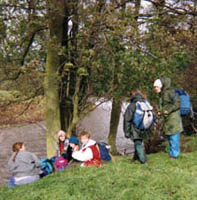
In 1990, we followed disused railway tracks and footpaths
north from Ashbourne to Bakewell, staying overnight in the
villages of Ilam, Hartington and Youlgreave. Jane and I
decide to retrace parts of our original 31-mile route – but
this time staying at the luxurious East Lodge Hotel, once
part of the Haddon estate.
Driving to Ilam, we find that eighteen years have done
nothing to dim the beauty of Dovedale. We walk upstream
through dramatic winding canyons, beneath limestone
pinnacles sculpted by frost and rain, across water meadows
into peaceful Wolfscote and Beresford dales, and on through
groves of beech, oak, rowan, wych elm and ash, planted for
cotton-mill bobbins. We remembered the river in flood, a
brown churning torrent covering the famous stepping stones,
but today the sun is out and the water is clear and
sparkling.
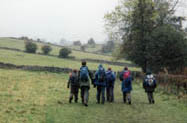 The youth hostels at Ilam and Hartington were – and are - in
stately houses - Ilam Hall an impressive National Trust
mansion with formal Italian gardens, parkland and woods;
Hartington Hall a 17th century manor house, where Bonnie
Prince Charlie reputedly stayed in 1745. Youth hostel rules
were strict 18 years ago. Jane and I remember arriving at
Hartington in pouring rain before the opening time of 5pm,
and huddling, cold and wet, in an outhouse in the stableyard.
Dormitories were spartan and draughty, and despite the herd
of cows mooing at the window, the kitchen provided only
powdered milk for breakfast. The youth hostels at Ilam and Hartington were – and are - in
stately houses - Ilam Hall an impressive National Trust
mansion with formal Italian gardens, parkland and woods;
Hartington Hall a 17th century manor house, where Bonnie
Prince Charlie reputedly stayed in 1745. Youth hostel rules
were strict 18 years ago. Jane and I remember arriving at
Hartington in pouring rain before the opening time of 5pm,
and huddling, cold and wet, in an outhouse in the stableyard.
Dormitories were spartan and draughty, and despite the herd
of cows mooing at the window, the kitchen provided only
powdered milk for breakfast.
How surprised we are to discover the changes here –
Hartington Hall is now a ‘four-star flagship hostel’ – the
grandest in Britain - open all day and available for
weddings, with a restaurant and alcohol license, a cyber
café and games room. The chilly outhouses are now carpeted
and centrally-heated ensuite bedrooms.

From Hartington, we plod along muddy lanes between green
hillsides dotted with sheep. The dry-stone walls are flecked
with the fossilised remains of sea creatures, and we
remember that the children were startled to learn that this
chilly landscape was once a shallow tropical sea with clear
lagoons and coral reefs. Reaching the old Tissington railway
track, we squeeze through some narrow stone stiles and join
 the High Peak Trail. A unique feature of the Peak District
is the way its industrial relics blend with the natural
scenery. The region was at the forefront of the industrial revolution and the Derwent valley between Derby and Matlock
Bath is now a World Heritage Site celebrating the birth of
the factory system in the late 18th century, and in
particular Arkwright’s famous water-powered cotton mills.
The landscape is dotted with derelict lead mines, discarded
millstones, old lime kilns, grindstones for sharpening
Sheffield steel, and quarries which once produced polished
limestone for black marble fireplaces, vases and brooches.
The High Peak Railway, built in 1830, was one of the
country’s first railway lines. Abandoned tracks and
silted-up canals now form a network of level trails, perfect
for walking. the High Peak Trail. A unique feature of the Peak District
is the way its industrial relics blend with the natural
scenery. The region was at the forefront of the industrial revolution and the Derwent valley between Derby and Matlock
Bath is now a World Heritage Site celebrating the birth of
the factory system in the late 18th century, and in
particular Arkwright’s famous water-powered cotton mills.
The landscape is dotted with derelict lead mines, discarded
millstones, old lime kilns, grindstones for sharpening
Sheffield steel, and quarries which once produced polished
limestone for black marble fireplaces, vases and brooches.
The High Peak Railway, built in 1830, was one of the
country’s first railway lines. Abandoned tracks and
silted-up canals now form a network of level trails, perfect
for walking.
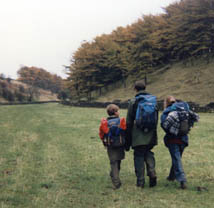
Longdale is still utterly unspoilt and deserted, a dry
valley which winds between gentle and then steep hillsides.
Later, we follow the tiny river Bradford through a
astonishingly lush valley of dense woodland and marshy
jungle. At each turn, another beautiful view opens up.

Youlgreave youth hostel is still in the former Coop, a tall,
grey 19th century building with signs saying ‘Groceries and
Provisions, Draperies and Clothing’. It is closed when we
arrive, but we wonder whether girls still sleep in
‘Furniture’ and boys in ‘Bedding’. The kitchen used to be in
‘Ladies’ Underwear’. Jane and I pop into the tiny post
office, and just as we did 18 years ago, we wait for twenty
minutes while the postmaster chats to a customer. When he
turns his attention to us, he is ready to chat for hours.
For southerners, the friendliness of Derbyshire people is
astounding and heart-warming.
Each evening we return to the welcome luxury of East Lodge
Hotel. Our bedroom has a window etched with lovesick
messages from Maud, a daughter of the house who was locked
in her bedroom in disgrace after falling pregnant. Now
Maud’s benevolent ghost watches over guests. The food in the
hotel’s Terrace Restaurant is superb – rack of lamb and
medallions of aged beef from neighbouring farms, and Stilton
cheese from Hartington.
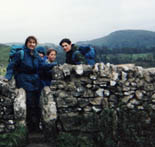 On our last afternoon, the sky darkens to indigo, the sun
slants across emerald fields, throwing inky shadows which
reveal dimples and undulations in the ancient pastures. A
few drops of rain fall, and a magnificent rainbow hovers in
the dark blue sky. Joining the 4x4s and high heels at the
Chatsworth Farm Shop, with its mesmerising cornucopia of
fine foods, we buy Dovedale Blue cheese made in Hartington,
Chatsworth honey and pickles, and some huge vine-tomatoes
which smell as tomatoes should. On our last afternoon, the sky darkens to indigo, the sun
slants across emerald fields, throwing inky shadows which
reveal dimples and undulations in the ancient pastures. A
few drops of rain fall, and a magnificent rainbow hovers in
the dark blue sky. Joining the 4x4s and high heels at the
Chatsworth Farm Shop, with its mesmerising cornucopia of
fine foods, we buy Dovedale Blue cheese made in Hartington,
Chatsworth honey and pickles, and some huge vine-tomatoes
which smell as tomatoes should.
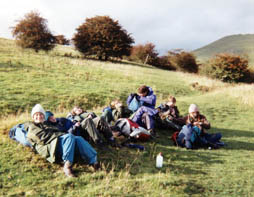 Eighteen years ago, our trek ended as we trudged over a 13th
century five-arched bridge into the busy market town of
Bakewell and – a rare and exciting treat – escaped the rain
in a café where we tucked into the town’s eponymous tarts.
The waitress explained to the children how the pudding was
invented by a local cook who poured egg over the jam by
mistake, instead of adding it to the pastry. Jane and I have
been luckier with the weather this time – no rain, and warm
spring sunshine. We haven’t had to carry our luggage, cook
our own pasta suppers, sleep in dormitories or do chores
after breakfast. We have lolled in bubble baths, dined on
exquisite food, and slept in warm, comfortable beds,
attended by the welcoming ghost of Maud. But we have been
accompanied on our walks by six other little ghosts,
stamping in puddles, falling over in the mud, chattering,
teasing, squabbling and laughing. Eighteen years ago, our trek ended as we trudged over a 13th
century five-arched bridge into the busy market town of
Bakewell and – a rare and exciting treat – escaped the rain
in a café where we tucked into the town’s eponymous tarts.
The waitress explained to the children how the pudding was
invented by a local cook who poured egg over the jam by
mistake, instead of adding it to the pastry. Jane and I have
been luckier with the weather this time – no rain, and warm
spring sunshine. We haven’t had to carry our luggage, cook
our own pasta suppers, sleep in dormitories or do chores
after breakfast. We have lolled in bubble baths, dined on
exquisite food, and slept in warm, comfortable beds,
attended by the welcoming ghost of Maud. But we have been
accompanied on our walks by six other little ghosts,
stamping in puddles, falling over in the mud, chattering,
teasing, squabbling and laughing.
First published by the Telegraph
©SarahShuckburgh
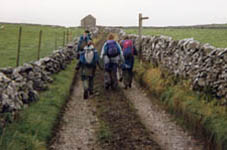
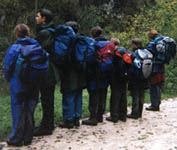

 |